Select Device Freestyle Lingo Freestyle Libre 3 Freestyle Libre 2 Freestyle Libre 14 Day Dexcom G7 Dexcom G6 Dexcom Stelo Guardian Connect Medtronic Simplera Eversense Meter Omnipod Omnipod Dash Medtronic 780G Medtronic 630G Tandem t:slim X2 Bigfoot Unity Medtronic InPen Tempo Pen NovoPen 6/NovoPen Echo Insulin Pen Afrezza CeQur Simplicity Patch V-Go Patch Omnipod GO Patch Syringe and Vial Beta Bionics iLet Pancreas Control IQ with Dexcom Control IQ with Freestyle Libre Medtronic 780G with Smart Guard Omnipod 5 Tandem Mobi Tidepool Loop twiist DIY Loop Apple Series 6/7/8/9/10/SE (2nd Generation) Garmin vívosmart 5™ Garmin Venu Sq 2 Garmin Venu 3 Garmin vivoactive 5 Garmin Fenix 8 Garmin vivofit jr 3 Garmin Forerunner 165/265/965 Garmin epix (Gen 2) Garmin Enduro 3 Fitbit Ace LTE Fitbit Charge 6 Fitbit Inspire 3 Fitbit Versa/Versa 2/4/Versa Lite Fitbit Sense 2 Fitbit Luxe Google Pixel 2/3 Samsung Galaxy 4/5 Xiaomi Mi Band 9 Oura Ring Whoop 4.0 Withings ScanWatch 2 Withings ScanWatch Lite Pedometer 3D Pedometer
Select Device Freestyle Lingo Freestyle Libre 3 Freestyle Libre 2 Freestyle Libre 14 Day Dexcom G7 Dexcom G6 Dexcom Stelo Guardian Connect Medtronic Simplera Eversense Meter Omnipod Omnipod Dash Medtronic 780G Medtronic 630G Tandem t:slim X2 Bigfoot Unity Medtronic InPen Tempo Pen NovoPen 6/NovoPen Echo Insulin Pen Afrezza CeQur Simplicity Patch V-Go Patch Omnipod GO Patch Syringe and Vial Beta Bionics iLet Pancreas Control IQ with Dexcom Control IQ with Freestyle Libre Medtronic 780G with Smart Guard Omnipod 5 Tandem Mobi Tidepool Loop twiist DIY Loop Apple Series 6/7/8/9/10/SE (2nd Generation) Garmin vívosmart 5™ Garmin Venu Sq 2 Garmin Venu 3 Garmin vivoactive 5 Garmin Fenix 8 Garmin vivofit jr 3 Garmin Forerunner 165/265/965 Garmin epix (Gen 2) Garmin Enduro 3 Fitbit Ace LTE Fitbit Charge 6 Fitbit Inspire 3 Fitbit Versa/Versa 2/4/Versa Lite Fitbit Sense 2 Fitbit Luxe Google Pixel 2/3 Samsung Galaxy 4/5 Xiaomi Mi Band 9 Oura Ring Whoop 4.0 Withings ScanWatch 2 Withings ScanWatch Lite Pedometer 3D Pedometer
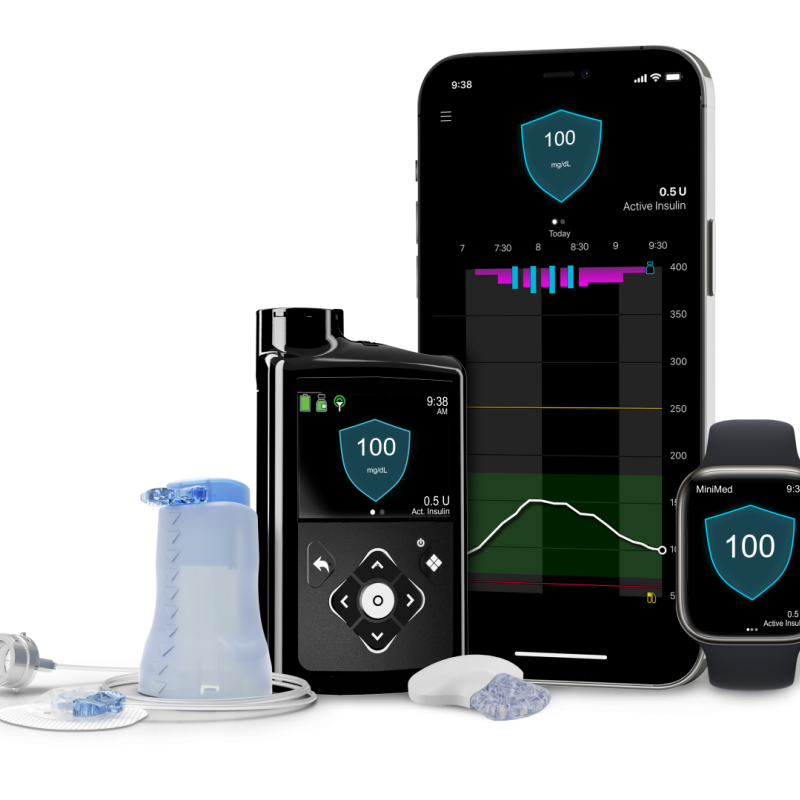
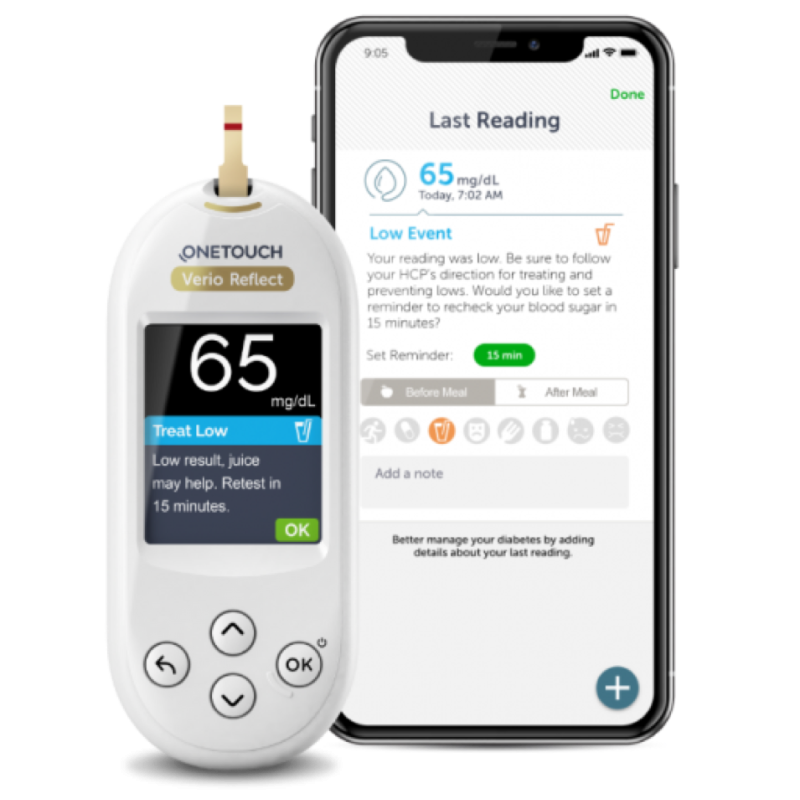
Summary
The Medtronic MiniMed™ 780G system is designed with SmartGuard™ technology, which can help with the occasionally missed meal or inexact carb counts. It provides automatic basal adjustments to manage glucose levels to a prespecified target (100 mg/dL [5.5 mmol/L], 110 mg/dL [6.1 mmol/L], or 120 mg/dL [6.7 mmol/L]) and auto correction bolus, every 5 minutes. The advanced hybrid closed-loop system uses current and past glucose trends from the Guardian™ 4 sensor to detect a rapid rise (e.g., a missed meal) in sensor glucose. No fingersticks required when the SmartGuard™ feature is active.
Good to have. Tried and true. Backup or day to day. Fingersticks required.
Components
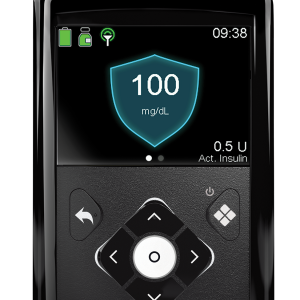
Medtronic 780G : Pump
Pump connects tubing to a small patch called an infusion set that attaches to the body.
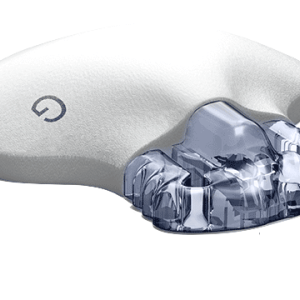
Medtronic 780G : Sensor
Sensor is inserted underneath the skin, either on the abdomen or arm.
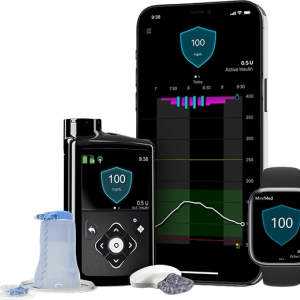
Medtronic 780G : Controller
Pump receives CGM readings and automatically adjusts insulin delivery. Data from the pump and CGM viewable on compatible smartphones.
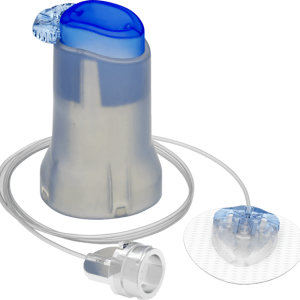
Medtronic 780G : Infusion Set
An infusion set contains the thin plastic tubing that delivers insulin from the pump to the body.

Generic Meter : Lancets
Tiny needle called a lancet is used to poke the skin (on a finger or on your arm) to get a small sample of blood. The lancing device is packaged with the glucometer.
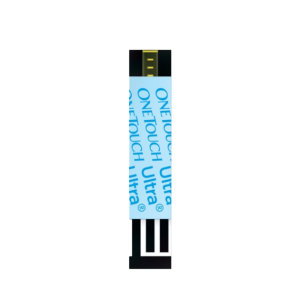
Generic Meter : Test Strips
The strips work with the glucose meters to “read” blood sugar levels. One box of test trips usually contains between 25-50 single use strips.
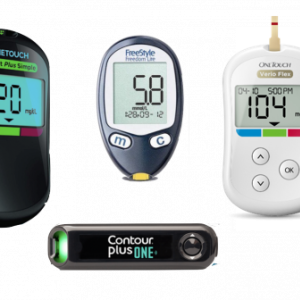
Meter : Glucometer
The meter measures the amount of sugar in the small sample of blood that is placed on the disposable test strip. Most CGMs require testing blood sugar with a meter to calibrate the CGM device daily.
Device Details
Overview
This system is integrated and has a customizable settings. Many providers are familiar with Medtronic products.
Good to have. Tried and true. Backup or day to day. Finger-sticks required.
Affordability and Access
$$$$
Coverage information is not yet available. Price range; $0-10,769 to start and $0-$300/Month. Price range varies depending on insurance coverage.
$$$$
Most accessible. Available over the counter at all Pharmacies. Price range; $0-$200/month depending on insurance coverage.
Data Monitoring Options
Yes
CareLink connect is available for care partners with up to five people who can follow a pump user and receive high and low notifications to help keep everyone in the loop.
Limited Options
Data is available directly on the device. Some meters may be compatible with the Tidepool data management system.
Data View Options
Yes
Data is viewed on compatible smart devices through the MiniMed Mobile App. You can download and view pump or CGM data on CareLink.
Yes
Data may be viewed directly on the device. Some meters contain a built-in USB connection that allows information to be uploaded to a data management system.
Duration and Storage
7-day pump 7-day sensor
Sensors last 7 days, transmitter needs weekly charging, store between 36 °F - 86 °F. Pump can be used for up to 7 days with the extended infusion set and works between 40ºF - 104ºF.
Daily
Meters can last several years with battery changes/charging, they're used daily and work between 65ºF-86°F
Vision / Auditory / Dexterity
NO text to speech
YES vibration alerts
A LOT of dexterity needed
NO text to speech
NO vibration alerts
A LOT of dexterity needed
Patient Considerations
Active Lifestyle
Temp Target. Manually increase blood sugar target range to 150 mg/dl during activity. Temp target can run 30 minutes to 24 hours in 30-minute increments. Auto corrections are disabled. The pump is not waterproof.
Must pause activity to check blood sugar.
Avoiding Highs and Lows
Customizable auto-bolus. Auto-correct bolus corrects highs if carb counts are miscalculated or bolus is occasionally missed. The system aims to maintain a target blood glucose level between 100 mg/dL and 120 mg/dL depending on personalized target glucose settings. Auto-bolus is available every 5 minutes to correct blood sugar between 100 mg/dL and 120 mg/dL (12 corrections per hour). Automatic insulin delivery settings are adjustable.
Less data. Meters don't give as much blood sugar data as sensors do and require a high level of engagement and effort to avoid highs and lows.
Comfort
Somewhat comfortable. Medtronic sensors need more tape than other sensors. Largest pump option.
Meter supplies carried and requires visible blood.
Easy Insulin Dosing
Automatically adjusts settings. Automatically adjusts insulin to reach personalized target between 100 mg/dL and 120 mg/dL. Will automatically revert to manual mode in certain situations. Basal and bolus in 0.025 increments. Extended bolus unavailable when using automated insulin delivery mode.
Limited features. No info on blood sugar trends.
Easy to Use
Easy software. Software makes many dosing decisions. Can be difficult to keep automatic insulin dosing features working. Requires fewer parts than do-it-yourself systems.
Large display. Device typically has large display numbers for easier readouts, and it's very simple to operate.
Fewer Fingersticks
Factory-calibrated sensor. Fingersticks needed for backup only.
Frequent fingersticks are unavoidable.
Privacy
Somewhat discrete. Ability to check blood sugar on phone or watch. Pump has tubing but can be clipped to clothing or placed in a pocket to be discreet when needed.
No attached device for blood glucose monitoring.